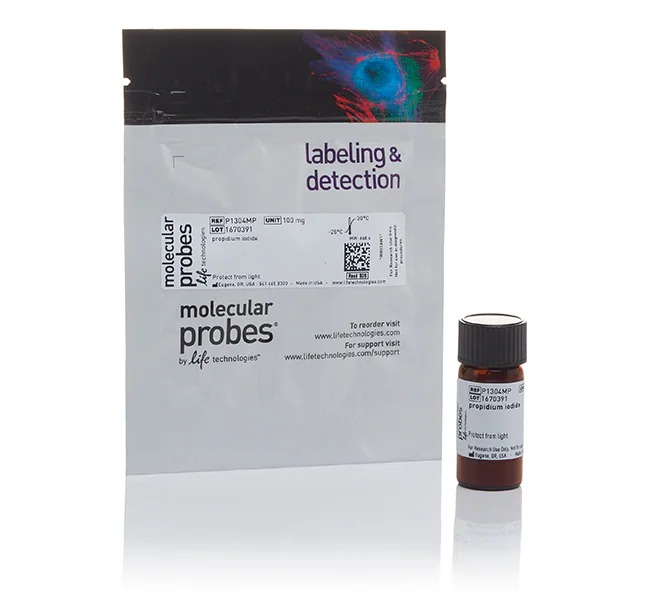Specifications:
| Application | Cell Analysis | ||
| Storage Temperature | 2-8°C | ||
| Product Type | Dye | Forms | Solid |
| Product Brand | Thermo Fisher Scientific™, Invitrogen | ||
| Product Grade | Molecular Biology | Formula | C₂₇H₃₄I₂N₄ |
Propidium iodide (PI) is a widely used red-fluorescent dye that acts as a nuclear and chromosome counterstain. It is commonly used to detect dead cells in a population, as it is not permeant to live cells. PI binds to DNA by intercalating between the base pairs with minimal sequence preference, resulting in enhanced fluorescence once bound. This characteristic makes PI an invaluable tool for cell viability assays and nucleic acid staining in various experimental setups.
When used in aqueous solutions, the dye exhibits excitation/emission maxima of 493/636 nm. Upon binding to DNA, the fluorescence of the dye is enhanced 20- to 30-fold, shifting the excitation maximum to 535 nm and the emission maximum to 617 nm, facilitating red fluorescence detection. PI is extensively used in fluorescence microscopy, confocal laser scanning microscopy, flow cytometry, and fluorometry, providing versatile applications across a range of cell biology, immunology, and genetic research.
Key Features:
-
Red Fluorescent Staining:
- PI binds to DNA, emitting red fluorescence when excited, making it ideal for visualizing DNA in dead cells during flow cytometry and microscopy.
-
Non-Permenant to Live Cells:
- PI is impermeable to live cells, making it useful for identifying dead cells and studying cell viability without affecting living samples.
-
High Fluorescence Enhancement:
- Once intercalated with DNA, PI fluorescence is enhanced 20-30 fold, resulting in high sensitivity and easy detection in fluorescence-based applications.
-
Versatile Applications:
- Ideal for fluorescence microscopy, confocal microscopy, flow cytometry, and fluorometry, where it is used to assess cell viability and DNA quantification.
-
Excitation/Emission Maxima:
- Excitation at 535 nm and emission at 617 nm ensures optimal performance when used with standard fluorescence filters.
-
Reliable for Dead Cell Detection:
- Perfect for use in dead cell exclusion assays, cell cycle studies, and apoptosis research.
Specifications:
| Feature | Details |
|---|---|
| Physical Form | Solution |
| Quantity | 100 mg |
| Recommended Storage | Store at room temperature and protect from light |
| Excitation/Emission | Excitation: 535 nm, Emission: 617 nm |
| Unit Size | Each |
Applications:
-
Dead Cell Detection:
- Propidium iodide is commonly used to assess cell viability by detecting dead cells in a population, especially in conjunction with flow cytometry.
-
Cell Cycle Studies:
- Used for analyzing DNA content and studying the cell cycle in various biological samples.
-
Apoptosis Studies:
- Ideal for detecting DNA fragmentation and monitoring cell death in apoptosis studies.
-
Fluorescence Microscopy and Confocal Imaging:
- Provides precise DNA staining in microscopic techniques, making it useful in cell biology and genetics research.
-
DNA Quantification:
- Used for quantifying DNA in biological samples through fluorescent detection methods like fluorometry.
-
Genetic and Immunological Research:
- Widely used in immunology, genetics, and pharmacology to monitor DNA integrity and cellular responses.
Storage:
- Store at room temperature and protect from light to maintain dye integrity and fluorescence properties for long-term use.
The Invitrogen™ Propidium Iodide dye is an essential tool for fluorescence-based cell analysis. With its ability to bind to DNA and emit strong red fluorescence, it is ideal for detecting dead cells, studying apoptosis, and conducting cell cycle analysis. Its versatility makes it suitable for use in microscopy, flow cytometry, and fluorometry applications in various fields such as genetics, cell biology, and pharmacology.




 0
0
